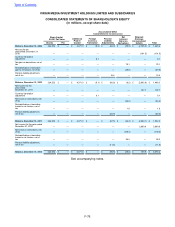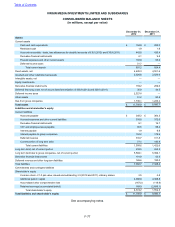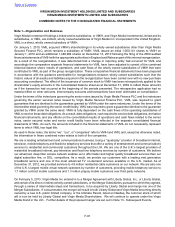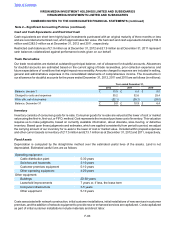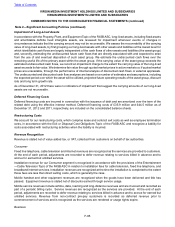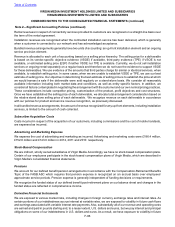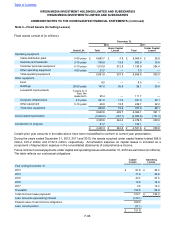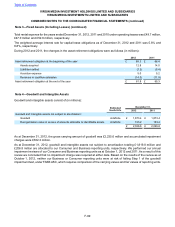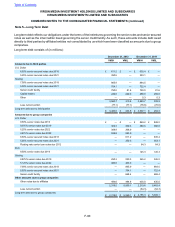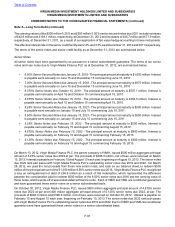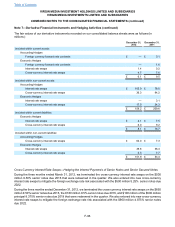Virgin Media 2012 Annual Report Download - page 157
Download and view the complete annual report
Please find page 157 of the 2012 Virgin Media annual report below. You can navigate through the pages in the report by either clicking on the pages listed below, or by using the keyword search tool below to find specific information within the annual report.
F-86
Rental revenues in respect of connectivity services provided to customers are recognized on a straight-line basis over
the term of the rental agreement.
Installation revenues are recognized when the contracted installation service has been delivered, which is generally
when a customer is connected to our network and has acknowledged acceptance.
Bundled revenue arrangements generally have two units of accounting: an up-front installation element and an ongoing
service provision element.
Revenue is allocated to each unit of accounting based on a selling price hierarchy. The selling price for a deliverable
is based on its vendor-specific objective evidence (VSOE) if available, third party evidence (TPE) if VSOE is not
available, or estimated selling price (ESP) if neither VSOE nor TPE is available. Currently, we do not sell installation
services or ongoing rental separately on a regular basis and therefore we do not have the evidence to support VSOE
for these deliverables. We use evidence of the amounts that third parties charge for similar or identical services, when
available, to establish selling price. In some cases, when we are unable to establish VSOE or TPE, we use our best
estimate of selling price. Our objective in determining the best estimate of selling price is to establish the price at which
we would transact a sale if the deliverable were sold regularly on a stand-alone basis. We consider all reasonably
available information including both market data and conditions, as well as entity specific factors. In addition, we
consider all factors contemplated in negotiating the arrangement with the customer and our own normal pricing practices.
These considerations include competitor pricing, customization of the product, profit objectives and cost structures.
Once we have established the selling price of each deliverable, we allocate total arrangement consideration based on
the relative stand alone selling price of each deliverable. We recognize revenue on each deliverable in accordance
with our policies for product and service revenue recognition, as previously discussed.
In all bundled revenue arrangements, the amount of revenue recognized for any up-front elements, including installation
services, is limited to the amount of cash collected.
Subscriber Acquisition Costs
Costs incurred in respect of the acquisition of our customers, including commissions and the cost of mobile handsets,
are expensed as incurred.
Advertising and Marketing Expense
We expense the cost of advertising and marketing as incurred. Advertising and marketing costs were £186.4 million,
£152.8 million and £143.0 million in 2012, 2011 and 2010 respectively.
Stock-Based Compensation
We are indirect, wholly owned subsidiaries of Virgin Media. Accordingly, we have no stock-based compensation plans.
Certain of our employees participate in the stock-based compensation plans of Virgin Media, which are described in
Virgin Media’s consolidated financial statements.
Pensions
We account for our defined benefit pension arrangements in accordance with the Compensation-Retirement Benefits
Topic of the FASB ASC which requires that pension expense is recognized on an accrual basis over employees’
approximate service periods. Pension expense is generally independent of funding decisions or requirements.
We recognize the funded status of our defined benefit post-retirement plans on our balance sheet and changes in the
funded status are reflected in comprehensive income.
Derivative Financial Instruments
We are exposed to various market risks, including changes in foreign currency exchange rates and interest rates. As
certain portions of our indebtedness accrue interest at variable rates, we are exposed to volatility in future cash flows
and earnings associated with variable interest rate payments. Also, substantially all of our revenue and operating costs
are earned and paid in pounds sterling and, to a lesser extent, U.S. dollars and euros, but we pay interest and principal
obligations on some of our indebtedness in U.S. dollars and euros. As a result, we have exposure to volatility in future
Table of Contents
VIRGIN MEDIA INVESTMENT HOLDINGS LIMITED AND SUBSIDIARIES
VIRGIN MEDIA INVESTMENTS LIMITED AND SUBSIDIARIES
COMBINED NOTES TO THE CONSOLIDATED FINANCIAL STATEMENTS (continued)
Note 2—Significant Accounting Policies (continued)


